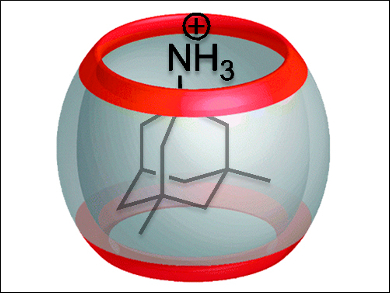There is a heavy focus in modern biochemistry on the search for new drugs and bioactive compounds. However, new drug delivery methods are also needed to make sure that the compounds are as effective as possible. One approach uses host-guest interactions in complexes, which can be tuned with external stimuli. Such complexes have included calixarenes, pillararenes, and cucurbiturils. The latter have high binding constants in aqueous media.
Nuno Basílio, Universidade NOVA de Lisboa, Caparica, Portugal, and Uwe Pischel, University of Huelva, Spain, have developed a trans-chalcone/flavylium photochromic system that can be successfully coupled to the complexation equilibrium of a drug-cucurbit[7]uril host-guest assembly. This system could be loaded with memantine (pictured), a drug used as in treating Alzheimer’s disease.
The drug could be controllably released in water under the illumination of UV light. This research is a proof-of-principle for new photoswitchable systems that can be used as drug delivery systems for a more efficient treatment of diseases.
- Drug Delivery by Controlling a Supramolecular Host-Guest Assembly with a Reversible Photoswitch,
Nuno Basílio, Uwe Pischel,
Chem. Eur. J. 2016.
DOI: 10.1002/chem.201603331




